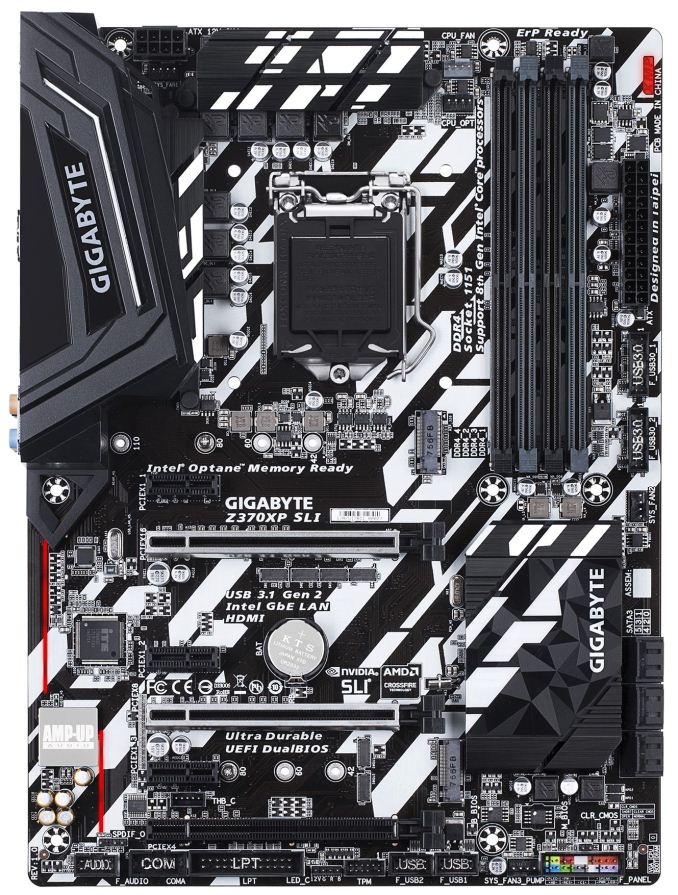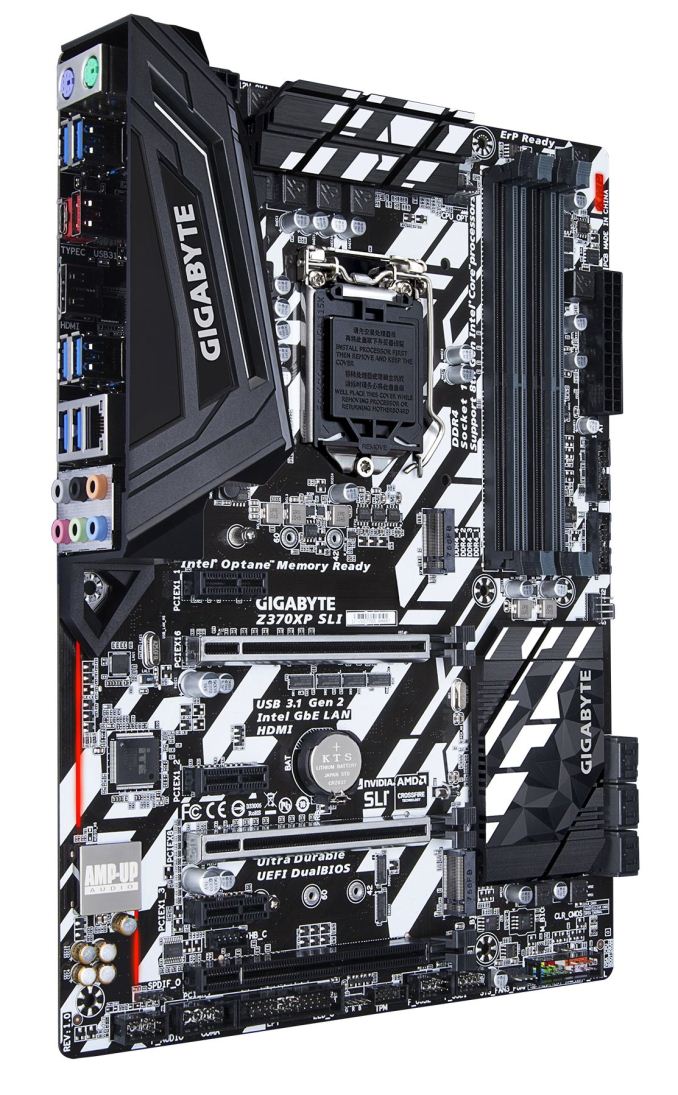Analyzing Z370 for Intel's 8th Generation Coffee Lake: A Quick Look at 50+ Motherboards
by Ian Cutress, Anton Shilov, Joe Shields & Gavin Bonshor on October 20, 2017 2:00 PM ESTGIGABYTE Z370XP SLI
The Z370XP SLI is not part of the Gaming line of motherboards from GIGABYTE, but part of its Ultra Durable series. The basic features of the Z370 platform can be found on the board, but fewer bells and whistles are included with one major exception, SLI (as given in the name).
One of the first things one may notice is a lack of RGB LEDs most anywhere on the board. The only places where we can find non-standard LED implementations are for the audio separation line and the XMP LED up the upper right-hand corner. As a drop down from higher up models, the memory slots are not reinforced, but two of the full-length PCIe lanes do have the reinforcement. There is a rear IO shroud present, covering only the back panel area while leaving the audio parts unprotected. The Z370XP SLI matches the Ultra Gaming in phase count, and by having two M.2 slots. In essence, this comes out as a simplified, non-RGB version of the Ultra gaming.
Clearly, the aesthetic has changed on the Z370XP SLI. It has the same black PCB color, however, the AORUS Falcon stenciling is gone and replaced by a bright white, with more prominent markings taking a wide path from the bottom in the audio section, through the PCIe area, socket and DIMMs covering most of the board. The VRM heatsinks and shroud are different, although the same IO shroud has been used from the other mid-range or lower boards in the product stack. The Ultra Gaming uses RGB LEDs under the shroud, while the XP SLI does not. The PCH is also styled a bit differently compared to the other boards in this lineup.
Like the other Z370 boards, the Z370XP SLI supports a total of 64GB RAM. The PCIe connector configuration is the same as the other boards with three full-length slots and three PCIe 1x slots. The first two full-length CPU connected PCIe slots (x16 or x8/x8) have the steel reinforcement so common on many boards but removes the RGB LEDs we have seen on other implementations in order to keep costs down. There are two RGB LED headers on the board, one of which can perform RGBW. The board supports two-way SLI and three-way Crossfire.
Moving on to storage, the Z370XP SLI has six SATA ports driven by the chipset, and there are two M.2 slots available; one supporting 110mm drives, the other 80mm. Both do not come with heat spreaders. Regarding fan headers, the board has a total of five scattered around the board with all being hybrid headers with the ability to be PWM or voltage controlled. Audio processing is handled by the Realtek ALC1220 codec and has EMI shielding on the IC itself. The network side of things is handled by a single Intel NIC, likely an Intel i219V, with ESD and Surge protection.
USB 3.1 (10 Gbps) is supported by the ASMedia 3142 controller and has a USB Type-C port as well as a Type-A port on the back panel. Six USB 3.1 (5 Gbps) ports are found on the back panel as well, while the remaining four USB 2.0 ports are available through internal USB headers. Display output from the CPUs integrated graphics is handled by a single HDMI port. Rounding out connectivity on the rear IO are two PS/2 ports, the Intel NIC, and the audio stack.
| GIGABYTE Z370XP SLI | |
| Warranty Period | 3 Years |
| Product Page | Link |
| Price | Amazon US |
| Size | ATX |
| CPU Interface | LGA1151 |
| Chipset | Intel Z370 Express |
| Memory Slots (DDR4) | Four DDR4 Supporting 64GB Dual Channel Support DDR4 4133+ |
| Network Connectivity | 1 x Intel GbE LAN |
| Onboard Audio | Realtek ALC1220 |
| PCIe Slots for Graphics (from CPU) | 1 x PCIe 3.0 x16 slots @ x16 1 x PCIe 3.0 x16 slots @ x8 |
| PCIe Slots for Other (from Chipset) | 1 x PCIe 3.0 x16 slots @ x4 3 x PCIe 3.0 x1 slots @ x1 |
| Onboard SATA | 6 x Supporting RAID 0/1/5/10 |
| Onboard SATA Express | None |
| Onboard M.2 | 2 x PCIe 3.0 x4 - NVMe or SATA |
| Onboard U.2 | None |
| USB 3.1 (10 Gbps) | 1 x Type-C (ASMedia) 1 x Type-A (ASMedia) 4 x Rear Panel |
| USB 3.1 (5 Gbps) | 6 x Rear Panel |
| USB 2.0 | 4 x Headers (Chipset) |
| Power Connectors | 1 x 24-pin EATX 1 x 8-pin ATX 12V |
| Fan Headers | 1 x CPU 1 x Watercooling CPU 2 x System Fan headers 1 x System Fan/ Water Pump header |
| IO Panel | 1 x PS/2.2 keyboard port 1 x PS/2 mouse port 1 x HDMI Port 6 x USB 3.1 ports 1 x USB 3.1 Type-C 1 x USB 3.1 Type-A 1 x RJ-45 LAN Port 6 x Audio Jacks |













83 Comments
View All Comments
weevilone - Wednesday, October 25, 2017 - link
Notable that though the new boards are often very similar to their Z270 predecessors, Asus has dropped Thunderbolt 3 support from the Maximus X Hero board.masouth - Thursday, October 26, 2017 - link
ASUS ROG Z370 Maximus X Hero"....new metallic heat sinks that are an upgrade over the plastic heatsinks found on the Z270 version"
Please excuse my ignorance because I didn't own a ROG Z270 mb but...plastic HEAT SINKS? Not shrouds or decoration over a heat sink but the actual heat sinks themselves? That's either wrong, they performed their job pretty poorly, or plastic resins have advanced a lot farther in thermal conductivity (and cost for such) than I realized.
flowrush - Sunday, November 19, 2017 - link
"The other main distinguishable feature is the inclusion of integrated 802.11ac Wi-Fi with an antenna (that can only be described as a shark fin) found on the F."The above is incorrect in the article. The integrated Wi-Fi module with antenna is found on the E not the F.
Coldgame - Saturday, November 25, 2017 - link
I'm looking to build a rig with the Z370 Gaming ITX/ac, a GTX-1070 card and an Apple Thunderbolt Display.The review states:
"The key difference in the support between the two boards is going to be the Thunderbolt 3 port on the Gaming-ITX. This port supports video outputs..."
So, can anyone confirm or deny that video generated by the GTX-1070 can be output through the onboard Thunderbolt 3 port?
hanselltc - Sunday, December 3, 2017 - link
Looking forward to low-middle end mITX choices from this platform. It'll probably be paired with a 8100/8300 and be my secondary machine.Roen - Sunday, February 4, 2018 - link
Where are the 10 Gbps ports on the back? They all look like 5 Gbps ports, even the Type C.rbarak - Wednesday, February 21, 2018 - link
Is anyone using the Z370-P on Linux with two screens?I built a new machine based on the Z370-P, and both the DVI and the HDMI connected screens show the same image, and the RHEL7 setup/displays show only one Unknown Display.
I follwed the advice on stackexchange, and added this line:
$ grep GRUB_CMDLINE_LINE_DEFAULT /etc/default/grub
GRUB_CMDLINE_LINE_DEFAULT="i915.alpha_support=1"
Then I did:
sudo grub2-mkconfig -o "$(readlink /etc/grub2.conf)"
And rebooted, but still, the two displays are not shown.
dromoxen - Wednesday, May 9, 2018 - link
Shocked to see that both the Asrock mitx boards are "szie=ATX" .. LOLThe addition of Tunderbolt sure seems to add a hefty premium £120 vs £160 , luckily I can do without.
Kroebo - Sunday, October 7, 2018 - link
Sadly, I discovered that the ZUG Gaming PLUS doesn't support SLI.trag - Tuesday, January 15, 2019 - link
On the ASrock Z370M Pro4 the M.2 slot information is backwards. Both slots support NVME. One slot also supports SATA. As written, "The first M.2 slot is SATA only while the second supports PCIe." it seems to say that one slot is SATA only and the other slot is PCIe (NVME) only.